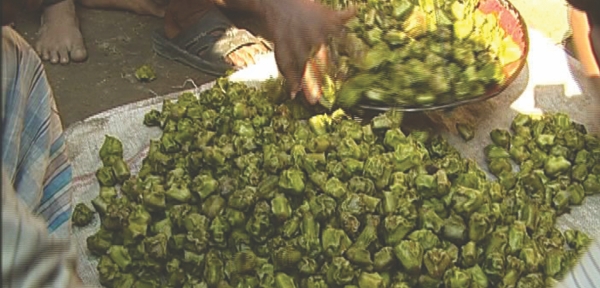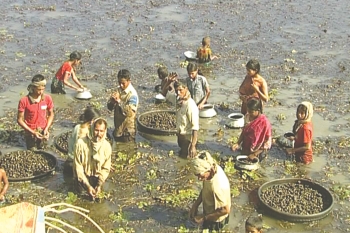Farmers’ Voice
Jamalpur
Gifted Wetlands
Bujimari beel (wetland) is situated in the Jamalpur district's Dewanganj upazila, a region very close to the Jamuna River, a place where river erosion has shattered the lives of thousands, who now live on river dams or highlands. As a result of river erosion, people have become 'ultra' poor. Seeking a new livelihood, the people have adopted a farming system in this wetland, mainly as water is the only resource they have to work with.
...............................................................................................................
Shykh Seraj

The fruit looks like a Singara. That's why it's locally called Singara. As this is grown in waters, it's often called the 'water chestnut', locally known as Paniphal. Before Bangladesh was liberated, a non-Bengali named Siddique experimentally grew water chestnuts here in Dewannganj. Since then, its farming has expanded. When Bangladesh had a small population without there being a risk of river erosion and comparatively less waterlogged lands, people used to voluntarily farm water chestnut. Who knew that this fruit would become the means of livelihood for the marginal people of the region one day?
As days go by, the number of river erosion victims is increases in Dewanganj. People, who once had lands and power, now have nothing at all and are forced to live in the clustered village over the dam. Their only source of income is to pluck or farm water chestnuts.
I had the opportunity to talk with Abdus Salam, a farmer from Dalbari village who explained the reasons behind the cultivation of this uncommon fruit and also about their livelihood status, circling around the ever-grasping river erosion. He's been growing water chestnuts for more than twenty years.
“The river has taken everything we had. There's nothing left for us except water chestnuts”, said a frustrated Salam.
“What about financial sustainability?” I asked.
“We're not entirely satisfied, but then again, we don't really have a choice” replied Salam.
Growing the fruit was survival for most, but then some farmers started commercial farming. Commercial farmers have helped the extension of water chestnut farming. They have chalked out profit in growing water chestnut.
“My production cost per bigha is only Tk. 3,000 but I can sell at up to Tk. 10,000 to 12,000”, said a pleased farmer by the name of Farid Uddin.
“So, you're making a good profit”, I congratulated.
“Yes, it's quite good”, replied a happy Farid.
The local people say that water chestnut first came to Jamalpur from Bogra. The experiment was good and successful, since then the fruit has been grown here in Dewanganj of Jamalpur district.
Ramzan Ali was a wealthy man. Jamuna River swallowed everything he had. Now, he belongs to the ultra poor community and water chestnuts is his only hope.
“We're river eroded people, people who previously had 200-300 bighas of land, now all of our property is under water. Land owners have become street beggars”, the ill fated farmer expressed their miserable past. Sawdagar (Merchant), another farmer and one who bears such a name also had plenty of lands and assets. Now, it's only the name that he has with him, nothing more.
Water chestnut farming is a natural farming system, adopted by the local farmers. Even the agriculture department wasn't aware about it a couple of months back. They didn't have a clear picture. Recently as the farming expanded and changed the agro-economic scenario, the agriculture department is now keener towards water chestnut. I spoke with the Dewanganj upazila agriculture officer, Sultan Ahmed regarding the problems, possibilities and the extension of water chestnuts.
“Does the agriculture department have any detailed guidelines on water chestnuts?”
“It hasn't come up in that way. I'm sure there will be clear guidelines and booklets very soon.”
“What about the extension?”
“Last year in Dewanganj upazila, farmers have done it on 70 hectares of land. This year, the farm area will increase up to 75-80 hectares.”
A few years ago, the dam had a distance of 15-18 kilometers from the Jamuna River. Within four or five years, the river has taken over most areas of the three unions of Dewanganj and started knocking on the doors of the dam. River eroded people say that the area of the beel (wetland) was huge and it produced plenty of water chestnuts. People can't grow water chestnuts like before. In many areas, it has stopped. I also encountered children plucking water chestnuts for their livelihood. I was shocked listening to one little girl there, named Ashia.
“The government is not supporting us. The former chairman gave us shelter at the school during the flood. Now we don't have any place to stay. We used to work at houses, and now we don't get any work. We have come down to the water so that we may have something to eat.”
“Where is your mother?”
“My mother doesn't stay with me.
“Where's your father?”
“He's left me.”
“Where do you stay, then?
“With my grandmother”
I requested Ashia to tell me what she wants and that I'll convey it to the concerned authority of the government.
“During the floods, we got shelter in the schools, but now, we don't get that facility. We don't get work at any homes where we could at least stay over in kitchens. Where should we go? Should we be left on roads? Are we dogs? We see many people living happily, eating well, and have buildings to stay in, but why is life so different for us? Ashia left me thinking.
I wondered how we can bring a smile on her face and for her community. Nobody has ever thought about development possibilities of the farming sector or the communities in the region. Why can't we see a fisheries project on the flood plain where the entire area is filled with water for almost the whole year?
There is a nearby market where the farmers send the water chestnuts. Many a times, the wholesalers also come to the farming area to collect water chestnuts. I went to the water chestnut market, which is quite old in Dewanganj. From Dewanganj bazaar (market), it spreads across all over Bangladesh.
I spoke with a wholesaler who's making huge profit whereas farmers, like always, can't make profit as they expect.
 “Where will you now send these water chestnuts?” “Where will you now send these water chestnuts?”
“To Dhaka, Bokshundor and Sherpur…”
“How much will you earn?”
“Tk 1,000”
“You bought each maund for Tk. 400 from the farmers and will sell each at Tk. 1,000. So, per maund your profit is Tk. 600.”
The conversation with the wholesaler tells us the story how disadvantaged farmers are in the distribution chain. Water chestnut is not a big item on the list of agricultural crops of Bangladesh. However, many lives depend on this fruit. The marginal farmers can't grow it, even though they know its commercial aspect. They pluck it and send them to market to earn some money. Also, they're using it as a source of nourishment. Research is needed to find out the nutrient qualities, industrial and commercial aspects of the fruit and what more could be produced from water chestnuts. At the same time, based on the livelihood diversity of the agricultural and marginal people of the region, measures could be taken for developing opportunities connected to the fruit.

Copyright
(R) thedailystar.net 2012 |


 “Where will you now send these water chestnuts?”
“Where will you now send these water chestnuts?”